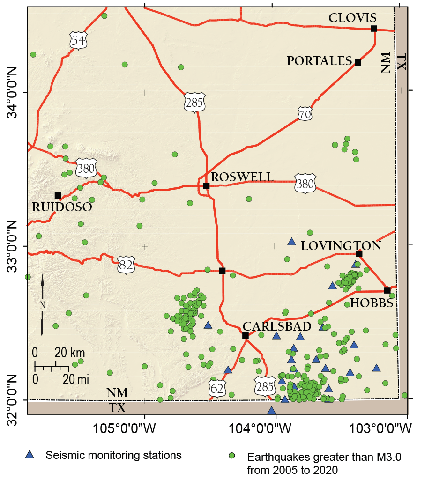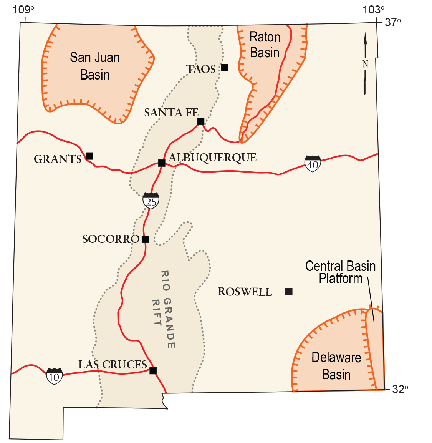‘Earth Matters’ newsletter focuses on induced seismicity in New Mexico
July 28, 2021
Bureau of Geology scientist Dr. Mairi Litherland summarizes earthquake activity linked to oil and gas activity
SOCORRO, N.M. – Bureau of Geology scientist Dr. Mairi Litherland recently wrote a paper about induced seismicity in New Mexico. The article is the featured piece in the summer 2021 edition of “New Mexico Earth Matters.”
 Litherland is the manager of the NMT Seismological Observatory, which includes an
array of 13 monitoring stations in the Delaware Basin in the southeast corner of New
Mexico and 9 stations in the rest of the state. Her article summarizes seismic activity
that correlates to hydraulic fluid injection in the oil fields.
Litherland is the manager of the NMT Seismological Observatory, which includes an
array of 13 monitoring stations in the Delaware Basin in the southeast corner of New
Mexico and 9 stations in the rest of the state. Her article summarizes seismic activity
that correlates to hydraulic fluid injection in the oil fields.
Here is an excerpt from Litherland’s article in Earth Matters. Follow the link at the bottom of this page to read the full article
Induced Seismicity in New Mexico
New Mexico experiences moderate levels of earthquake activity, primarily because of extension along the Rio Grande rift, a large, fault-bounded geologic valley that runs north-south through the center of the state.
 Geologic studies of ancient earthquakes (known as paleoseismology) show that earthquakes
as large as magnitude 6.5 (M6.5) or larger have occurred along the Rio Grande rift
within the past several thousand years, and smaller earthquakes of M2.5–3.5 take place
in various parts of the state every year. The highest concentration of naturally occurring
earthquakes is near the Socorro Magma Body, where a M6.2 earthquake occurred on November
15, 1906. This was the largest historic earthquake in New Mexico and it damaged several
buildings in Socorro.
Geologic studies of ancient earthquakes (known as paleoseismology) show that earthquakes
as large as magnitude 6.5 (M6.5) or larger have occurred along the Rio Grande rift
within the past several thousand years, and smaller earthquakes of M2.5–3.5 take place
in various parts of the state every year. The highest concentration of naturally occurring
earthquakes is near the Socorro Magma Body, where a M6.2 earthquake occurred on November
15, 1906. This was the largest historic earthquake in New Mexico and it damaged several
buildings in Socorro.
Although there is a long history of naturally occurring seismicity in New Mexico, increasing numbers of earthquakes have been observed over the past several years in some parts of the state that did not experience much seismic activity in the past. These earthquakes are believed to be associated with human activities rather than tectonic or magmatic forces, and are referred to by the term “induced seismicity.” Even though most induced earthquakes are too small to be felt by humans, or to cause any damage, in some places around the world induced earthquakes have damaged buildings and infrastructure. This has led to the installation of new monitoring stations in many areas to better understand the causes of induced seismicity and to minimize its risk. …
Follow this link for the full Summer 2021 issue of "New Mexico Earth Matters":
https://geoinfo.nmt.edu/publications/periodicals/earthmatters/21/n2/em_v21_n2.pdf